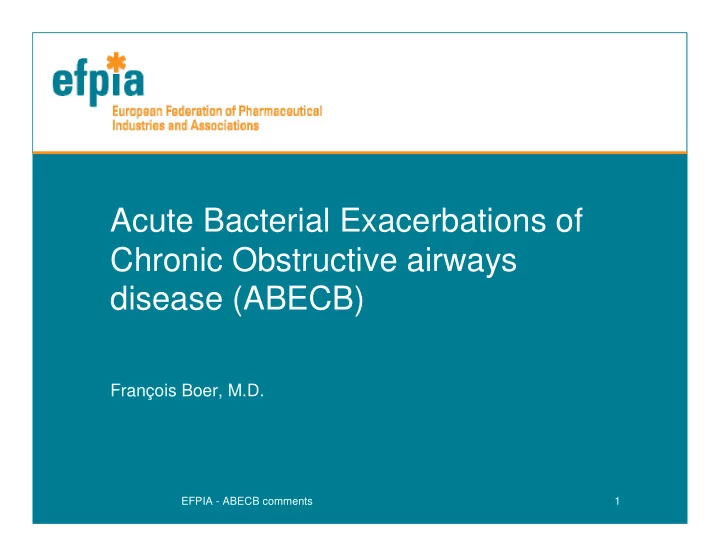

Acute Bacterial Exacerbations of Chronic Obstructive airways disease (ABECB) François Boer, M.D. EFPIA - ABECB comments 1
ABECB key issues • ABECB are a common cause of morbidity & mortality in COPD patients • Therapies include both pharmaceutical and non-pharmaceutical measures • Strategies are also needed for prevention • Guidelines are numerous and not aligned on antibiotic strategy: – Canadian Thoracic Society (http://www.respiratoryguidelines.ca/guideline/chronic obstructive-pulmonary-disease) – Global initiative for chronic obstructive lung disease (GOLD report) (http://www.goldcopd.com/download.asp?intId=556) – American Thoracic Society (http://www.thoracic.org/clinical/copd-guidelines/index.php) – European Respiratory Society and American Thoracic Society position paper (B.R. Celli, W. MacNee, and committee members Standards for the diagnosis and treatment of patients with COPD: a summary of the ATS/ERS position paper Eur Respir J 2004; 23: 932–946) – National Institute for Clinical Excellence (NICE) (http://www.nice.org.uk/nicemedia/live/13029/49425/49425.pdf) • Antibiotic resistance continues to emerge and new effective therapies will always be needed EFPIA - ABECB comments 2
Efficacy endpoint • The overall concept from existing clinical guidelines is that the anti-microbial treatment has to be tailored = the right antibiotic for the right patient at the right moment of the disease • Definitions of exacerbation & response are inconsistent across guidelines – there is no obvious best choice for clinical trials • Consequences: a well-conducted study based on European Guidelines endpoints maybe not approvable for registration in other regions because the endpoints are not viewed as valid • Although, use of a Patient-Reported Outcome (PRO) instrument has been suggested as desirable, there is no validated PRO available at present EFPIA - ABECB comments 3
Study design • Placebo-controlled studies for the patients with severe syndromes and bacteriology may be difficult to enroll – Mortality effects are suggested by meta-analysis (Ram FSF, Rodriguez-Roisin R, Granados-Navarrete A, Garcia-Aymerich J, Barnes NC. Antibiotics for exacerbations of chronic obstructive pulmonary disease. Cochrane Database of Systematic Reviews 2006, Issue 2. Art. No.: CD004403. DOI:10.1002/14651858.CD004403.pub2) – An equipoise problem similar to AOM may thus exist • Placebo-controlled superiority studies in low-risk patients are unlikely to show meaningful benefit – Placebo response will be high due non-pharmaceutical and non-antibacterial pharmaceutical therapies EFPIA - ABECB comments 4
Resistance • ABECB appears to be recurrent acquisition of new strains +/- resistance (Veeramachaneni SB, Sethi S. Pathogenesis of bacterial exacerbations of COPD; COPD. 2006 Jun;3(2):109-15) • For patients with susceptible pathogens, active-controlled superiority studies are unlikely to show an advantage over a properly dosed control agent • Enrolling only patients infected with resistant organisms into an active-controlled superiority design would be difficult: – An active comparator is needed where possible – A single comparator might not be possible due to differences in resistance patterns EFPIA - ABECB comments 5
Prophylaxis • Still a controversial question for ABECB • The Cochrane Collaboration reviewed nine trials involving 1055 subjects, but all these trials took place before 1970 (Staykova T, Black PN, Chacko EE, Poole P. Prophylactic antibiotic therapy for chronic bronchitis. Cochrane Database of Systematic Reviews 2001, Issue 2. Art. No.: CD004105.) • Their conclusion is that benefits for some patients are limited but these trials are really too old, the current antibiotic portfolio is different, and the resistance pattern has changed • For prophylaxis, the draft guidance (section 4.2.2) recommends placebo-controlled studies when the role of prophylaxis has not been established, with a clear definition of “breakthrough” cases: again we face here a lack of definition and validated endpoints • In addition, it is not clear that prophylaxis is consistent with good antibiotic stewardship EFPIA - ABECB comments 6
Conclusion on ABECB • Development of new drugs for ABECB is unlikely – We lack a clear definition of exacerbation for ABECB – We lack uniform ABECB risk stratification strategies • Little progress can be made without these tools – Widely accepted & standardized efficacy endpoints (and/or a PRO) need to be defined and agreed with Regulators, Institutes, and relevant Societies • Even with such tools, a requirement for superiority outcomes will make the area challenging EFPIA - ABECB comments 7
Recommend
More recommend